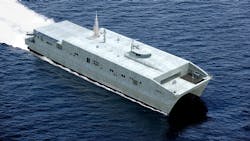Navy asks six companies to study building large unmanned surface ship to carry cargo, sensors, and weapons
WASHINGTON – U.S. Navy autonomous marine vessel experts are asking six shipbuilding companies to study different concepts for a large unmanned surface vessel (USV) able to carry cargo, sensors, and weapons to augment the Navy’s manned surface force.
Officials of the Naval Sea Systems Command in Washington announced contracts collectively worth $62.1 million to the six companies on Friday for separate conceptual designs of the Large Unmanned Surface Vessel (LUSV).
Companies receiving LUSV concept design awards are Huntington Ingalls Inc. in Pascagoula, Miss. ($13.1 million); the Lockheed Martin Corp. Rotary and Mission Systems segment in Baltimore ($11.3 million); Marinette Marine Corp. in Marinette, Wis. ($10.2 million); Bollinger Shipyards Lockport LLC in Lockport, La. ($9.4 million); Austal USA LLC in Mobile, Ala. ($9.1 million); and Gibbs & Cox Inc. in Arlington, Va. ($9 million).
This kind of unmanned surface ship is expected to carry as much as 40 tons of personnel and cargo, and operate in 8-to-13-foot waves for as long as 90 days without a human crew.
Related: Pentagon gets serious about unmanned surface vessels
The LUSV would use technology developed under the Sea Hunter project of the U.S. Defense Advanced Research Projects Agency (DARPA) and the Office of Naval Research in Arlington, Va.
Initial phases of LUSV development will involve a prototype unmanned ship with a range of 4,500 miles amid waves as high as 13 feet, and the ability to generate as much as power as 75 kilowatts of 450-volt, 60 Hz, three-phase power for on-board electronic payloads.
At this early stage, Navy experts envision a LUSV about 200 to 300 feet long -- about a third the size of a future Navy frigate.
Other details, dimensions, and performance specifications of the LUSV are classified. With a large payload capacity, the LUSV will be designed to conduct a variety of warfare operations independently or with manned surface combatants.
The LUSV will be capable of semi-autonomous operation, with operators controlling the vessel remotely, or through autonomous operations. U.S. Marine Corps leaders, for example, plan to use the future LUSV for long-range resupply missions, and troop transport, says Lt. Gen. Eric Smith, commander of the Marine Corps Combat Development Command at Quantico Marine Base, Va.
The future Navy LUSV could rendezvous with Navy amphibious assault ships offshore to move Marines and supplies quickly where needed, at perhaps lower costs and less risk to human ship crews than is possible today.
In addition to the Marine Corps desired cargo, transport, and surveillance missions, the future LUSV also might be able to carry payloads for electronic warfare, anti-surface warfare, and land-strike warfare. The six companies should complete their concept design work on the future LUSV by September 2024.
For more information contact Huntington Ingalls online at https://huntingtoningalls.com; Lockheed Martin Corp. Rotary and Mission Systems at www.lockheedmartin.com; Marinette Marine Corp. at https://fincantierimarinegroup.com/about-us/us-shipyards/marinette-marine; Bollinger Shipyards Lockport at www.bollingershipyards.com/locations/bollinger-lockport; Austal USA at https://usa.austal.com; Gibbs & Cox at https://www.gibbscox.com; or Naval Sea Systems Command at www.navsea.navy.mil.

John Keller | Editor-in-Chief
John Keller is the Editor-in-Chief, Military & Aerospace Electronics Magazine--provides extensive coverage and analysis of enabling electronics and optoelectronic technologies in military, space and commercial aviation applications. John has been a member of the Military & Aerospace Electronics staff since 1989 and chief editor since 1995.

